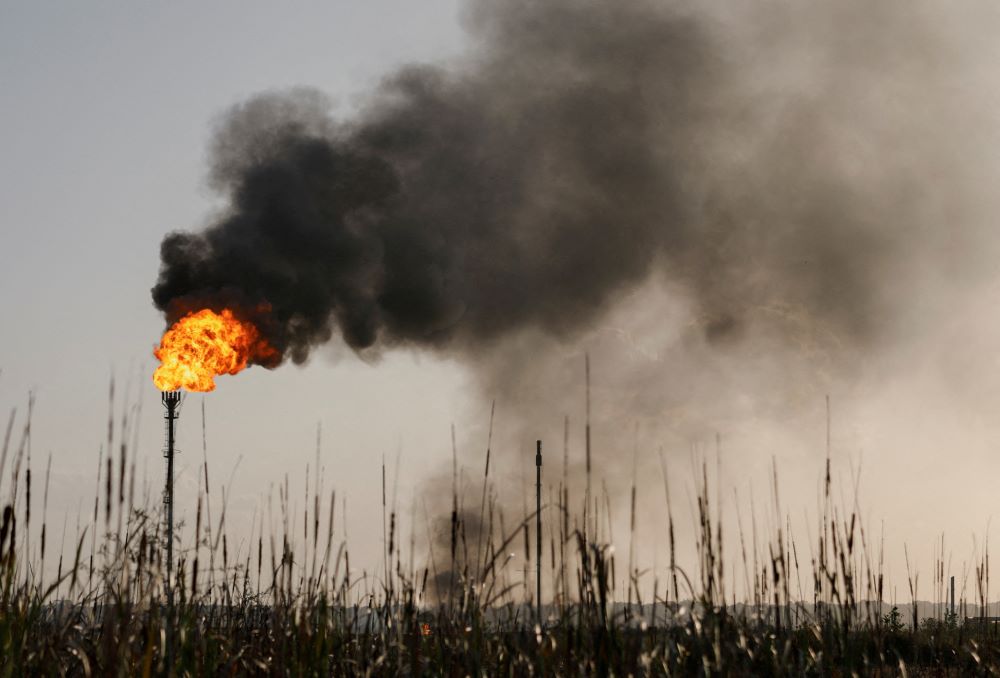Gas flaring from oil production increased in 2023, with pledges and new rules aimed at curbing methane emissions yet to make a difference
Gas flaring – where oil and gas companies burn off gas released during oil extraction – increased around the world last year to its highest level since 2019, despite a growing international push to regulate and curb the polluting practice.
According to satellite data released by the World Bank on Thursday, gas flaring increased by 7% in 2023, reversing a decline in 2022. The rise resulted in extra planet-warming emissions equivalent to 23 million tonnes of carbon dioxide (CO2) – similar to adding about 5 million cars to the roads, it said.
Gas flaring emits greenhouse gases including black carbon and methane, which has a warming effect about 80 times more potent than CO2 over a 20-year period.
The top flaring countries in 2023 were Russia, Iran, Iraq and the United States, with just nine countries responsible for 75% of gas flaring globally.
Last year also saw an uptick in the intensity of flaring, meaning the amount of gas flared per barrel of oil produced, as oil prices spiked above $90 a barrel in the autumn.
In some countries, such as Iran and Libya, increased flaring intensity was attributed to increased oil production, coupled with a lack of investment in and prioritisation of gas recovery and utilisation.
Intensity was also high in countries affected by conflict, such as Syria, where operators struggle to address flaring.
“We’re hopeful that this is somewhat of an anomaly and the longer-term trend will be dramatic reductions,” said Zubin Bamji, manager of the World Bank’s Global Flaring and Methane Reduction (GFMR) Partnership, which monitors flaring and supports governments and oilfield operators to reduce related emissions.
Decoupling trend
That hope is underpinned by the “decoupling of a long-standing correlation between oil production and gas flaring” since the late 1990s, Bamji explained in emailed comments.
Operators can minimise flaring through measures such as re-injecting gas back into the earth or capturing it for utilisation.
Demetrios Papathanasiou, director of the World Bank’s energy and extractives global practice, said in a statement on the data that if the wasted gas were captured and used, it could displace dirtier energy and generate enough power to double electricity supplies in sub-Saharan Africa.
EU warns “delaying tactics” have made plastic treaty deal “very difficult”
But others argue that using flared gas more efficiently – or regulating flaring and its related methane emissions – will not be eliminate the practice as long as fossil fuels are still being produced.
“The number one thing we need to do is put the oil and gas industry into decline,” said Lorne Stockman, research co-director at Oil Change International (OCI), a nonprofit group that campaigns against fossil fuels.
Pledges versus regulation
The increase in flaring suggests that growing global attention and initiatives to eliminate flaring have not been “sufficient or sustainable enough”, according to the World Bank’s report.
Operators and countries representing about 60% of flaring worldwide have endorsed the World Bank’s Zero Routine Flaring by 2030 (ZRF) initiative, while 155 countries have signed a Global Methane Pledge, launched at the COP26 climate summit in 2021, to collectively cut methane emissions.
Jonathan Banks, global director of methane pollution prevention at Clean Air Task Force, an environmental group focused on decarbonising energy, said those initiatives are “helpful”.
But, he added, governments and companies are still “not doing nearly enough” to stop flaring, whether in the form of policies to force businesses to take action or energy firms’ own plans and investments.
Despite dilution, officials say new nature law can restore EU carbon sinks
That is changing, Banks said, referring to recently introduced regulations in the United States, Canada and the European Union which aim to reduce methane emissions. “But those new policies take time to be implemented and enforced,” he noted.
The EU’s Methane Strategy, adopted in May, will include a methane transparency requirement on gas imports that looks to penalise gas flaring and venting – an even more polluting practice of releasing unignited gas.
“The potential to use access to the European market as a way to drive action is huge,” Banks said, adding that only a global standard, applied to all internationally traded oil and gas, could bring an end to flaring and venting.
US gas “certification”
Without such a standard, oil and gas companies are in practice policing themselves when it comes to curbing flaring and methane emissions more broadly.
In the US, for example, third-party gas “certification” companies track met
Read More

